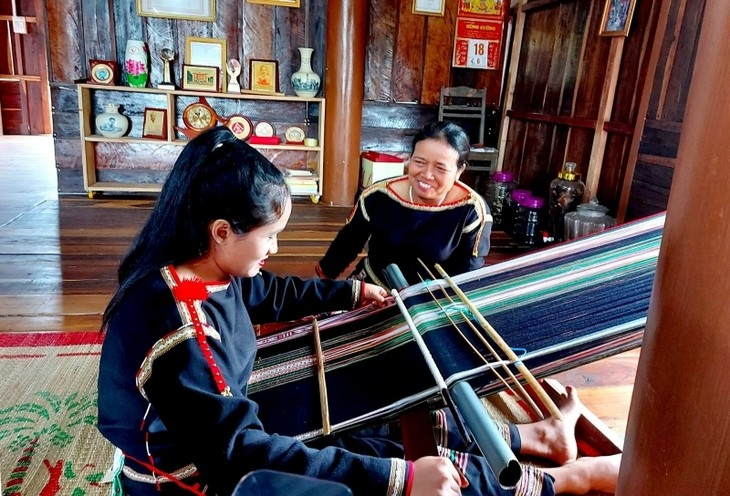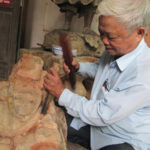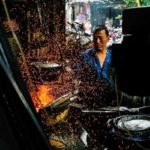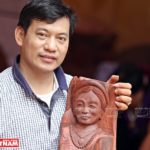Brocade products are highly regarded among the Ede women for their impeccable craftsmanship. The Ede community has managed to preserve this traditional craft and has recently transformed it into a reliable source of income.
“I learned the art of weaving when I was 15 years old. Through practice and dedication, I have become extremely proficient in this craft and have also had the opportunity to impart my knowledge to others. Some of my students have even won prizes in weaving competitions and continue to contribute to the promotion of this exquisite craft.” Artisan H’Blong Knul from Ja hamlet, Krong Bong district, patiently instructs her daughters on the art of spinning yarn, setting it on the loom, and creating intricate patterns for a brocade dress.
According to H’Giang Knul, one of her daughters, all three sisters have honed their skills in crafting a wide array of Ede costumes.
“Although it was challenging initially, I gradually mastered the art of spinning yarn, weaving, and stitching the hems of clothes adorned with traditional Ede patterns,” shared H’Giang Knul.
Like other ethnic groups residing in the Central Highlands, the Ede people primarily employ cotton yarn for brocade weaving. What distinguishes Ede brocade costumes are their motifs, characterized by vibrant hues such as black, red, yellow, blue, and white.
H’Nun Byă, a talented artisan from Ea Kao commune, Buon Ma Thuot city, highlighted the process of thread preparation and dyeing, involving the utilization of mud, leaves, roots, and tree bark, upon harvesting.
“Floral patterns on our brocade costumes are typically depicted in white, black, and red. We craft various patterns, each requiring either 15, 17, 27, or 35 threads. However, the most intricate challenge lies in weaving embossed patterns,” explained H’Nun Byă.
Ede brocade motifs intricately portray elements from the Ede community’s daily life, encompassing birds, turtles, lizards, flowers, plants, fruits, and essential household items such as rice mills and stilt houses. Furthermore, they meticulously design elaborate decorations and pattern arrangements in accordance with specific occasions.
Men’s shirts are often adorned with a red stripe on the front, resembling the shape of an eagle’s wings. Dragon or eagle motifs, symbolizing strength and the innate desire to conquer nature, are woven along the shirt’s sides and hem.
For their everyday wear, Ede women fashion oversized brocade skirts featuring simple patterns, which they elegantly tie around their waists, ensuring coverage down to their ankles. On the other hand, festive and special occasion costumes are lavishly ornamented with vibrant patterns on a black background.
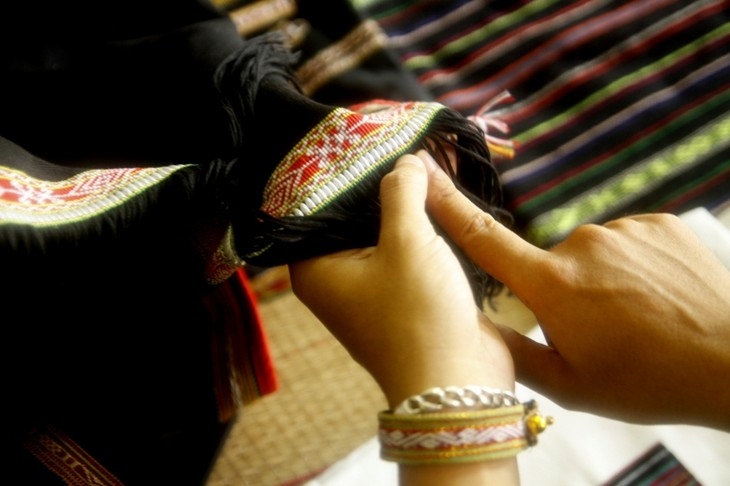
According to H’Yar Kbuôr from Drai Sap commune, Krong Ana district, the Ede women utilize the Kteh weaving technique, a celebrated form of brocade decoration art. This technique entails weaving parallel patterns using red and white threads, embellished with beads on the shirt’s or loincloth’s hem, stated Kbuôr.
‘The Kteh technique is employed in the crafting of ceremonial costumes and garments intended for noble individuals. Mastering the Kteh technique requires exceptional skill and talent; it is not an ability possessed by all.’
Based on existing popular patterns, each Ede woman excels in creating new motifs by incorporating additional yarns and blending colors, resulting in unique products. H’Yam Bkrong, an artisan from Ea Kao commune, emphasized that brocade fabric encapsulates a woman’s devotion, as it demands an investment of her time, dedication, meticulousness, and creativity.
“It takes approximately a year to complete a single brocade fabric. The process entails preparing cotton, spinning threads, dyeing, weaving on a loom, and meticulously stitching every seam to fashion the garments,” elaborated H’Yam Bkrong.
Historically, crafting brocade products required substantial time and effort, limiting their usage to within the family or as thoughtful gifts. However, with the emergence of factory-produced thread and the fusion of traditional Ede patterns and colors with contemporary commercial materials, these products have successfully appealed to a broader customer base. Ede women now skillfully create commercially viable brocade items without forsaking their intrinsic traditional values.
Dong Binh Griddle Cakes
Located on the outskirts of Tuy Hoa City in the province of Phu Yen, the ancient village of Dong Binh is well known for the traditional craft of making griddle cakes that has existed for hundreds years. It is widely acknowledged that the griddle cakes from the village are more delicious than those from other regions of the country.
Vietnam’s Youngest Artisan
After many failures, Nguyen Tran Hiep, who had always wanted to get rich from the traditional craft in his hometown of Tu Son in the northern province of Bac Ninh, finally succeeded when he became the youngest national artisan in Vietnam at the age of 37. Thanks to a drastic renovation and a large investment, his small workshop, Hiep Thang, developed into a large scale fine-art furniture cooperative which has changed the thinking and the old way of practicing the craft of many locals in the region.

